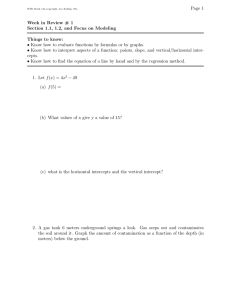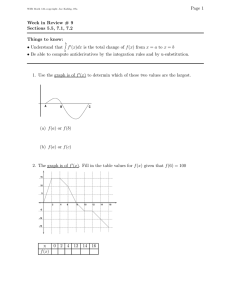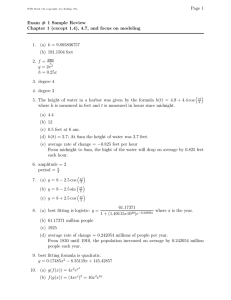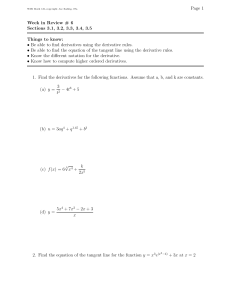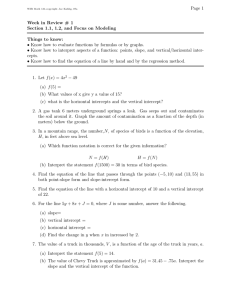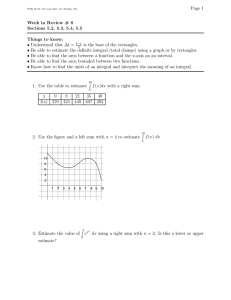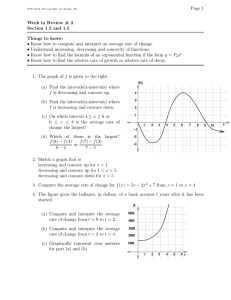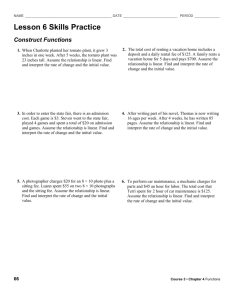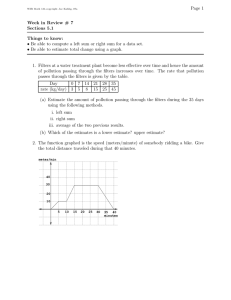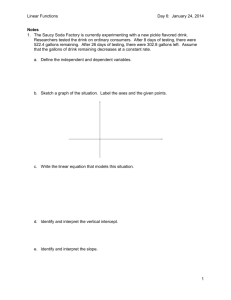Page 1 Exam # 1 Sample Review
advertisement
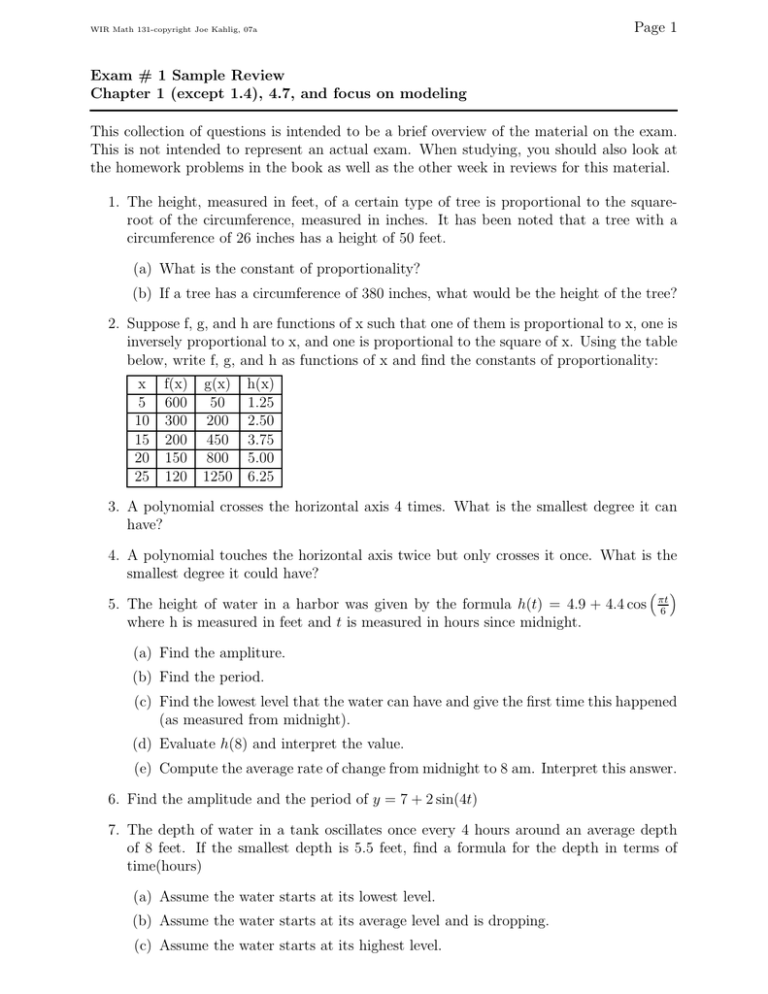
WIR Math 131-copyright Joe Kahlig, 07a Page 1 Exam # 1 Sample Review Chapter 1 (except 1.4), 4.7, and focus on modeling This collection of questions is intended to be a brief overview of the material on the exam. This is not intended to represent an actual exam. When studying, you should also look at the homework problems in the book as well as the other week in reviews for this material. 1. The height, measured in feet, of a certain type of tree is proportional to the squareroot of the circumference, measured in inches. It has been noted that a tree with a circumference of 26 inches has a height of 50 feet. (a) What is the constant of proportionality? (b) If a tree has a circumference of 380 inches, what would be the height of the tree? 2. Suppose f, g, and h are functions of x such that one of them is proportional to x, one is inversely proportional to x, and one is proportional to the square of x. Using the table below, write f, g, and h as functions of x and find the constants of proportionality: x f(x) 5 600 10 300 15 200 20 150 25 120 g(x) h(x) 50 1.25 200 2.50 450 3.75 800 5.00 1250 6.25 3. A polynomial crosses the horizontal axis 4 times. What is the smallest degree it can have? 4. A polynomial touches the horizontal axis twice but only crosses it once. What is the smallest degree it could have? 5. The height of water in a harbor was given by the formula h(t) = 4.9 + 4.4 cos where h is measured in feet and t is measured in hours since midnight. πt 6 (a) Find the ampliture. (b) Find the period. (c) Find the lowest level that the water can have and give the first time this happened (as measured from midnight). (d) Evaluate h(8) and interpret the value. (e) Compute the average rate of change from midnight to 8 am. Interpret this answer. 6. Find the amplitude and the period of y = 7 + 2 sin(4t) 7. The depth of water in a tank oscillates once every 4 hours around an average depth of 8 feet. If the smallest depth is 5.5 feet, find a formula for the depth in terms of time(hours) (a) Assume the water starts at its lowest level. (b) Assume the water starts at its average level and is dropping. (c) Assume the water starts at its highest level. Page 2 WIR Math 131-copyright Joe Kahlig, 07a 8. The table gives the population of a country in millions. Year 1790 1830 1870 1910 1950 1990 population 2 5.5 12.3 25.9 38.5 50.8 (a) Find the best fitting formula for the data. (b) Estimate the limiting population. (c) In what year does the function change from concave up to concave down? (d) Find and interpret the average rate of change from 1830 to 1910. 9. The table lists the time in seconds that an average athlete takes to swim 100 meters freestyle at a certain age. Age 8 12 16 time 92 70 58 20 24 28 32 51 49 53 60 Find the best fitting formula for the data. Justify your answer. 10. Let f (t) = t2 and g(t) = 4tet . Find (a) g(f (x)) (b) f (g(x)) 11. Describe how the graph of 2f (x − 3) + 6 differs from the graph of f (x). 12. solve for x. Ae1.5x = 7e2.4x 13. Your parents have started a bank account for you with $6,000. The bank account earns interest at a rate of 5% compounded continuously. At the end of five years you make a one-time withdrawl of $2500. Find the times where the ballance of the account was $7000. Give your answers from the start of the account. 14. A chemical has a continuous rate of decay of 14% and time is given in years. (a) What is the relative rate of decay? (b) How long until 37% of the chemical is gone? 15. A bee colony has 500 worker bees. If the colony is growing at a rate of 4% per week. (a) What is the continuous growth rate. (b) How long does it take the number of workers to triple? 16. A radioactive chemical was spilled and the radiation level was 2.8 millirem/hour, which is 5 times the safe level recommended by the government. After three hours the radiation level was 2.629millirem/hour. (a) Find the formula, f (x), that gives the radiation level as a function of time when the radiation level is decaying at a continuous rate. (b) Compute f (4) and interpret the answer. (c) How long until it is safe for people to return to the area? (d) What is the half-life of the chemical? WIR Math 131-copyright Joe Kahlig, 07a Page 3 17. Find the equation of the line through the point (7, 15) and has an average rate of change of 8 from x = 4 to x = 9. 18. Find the equation of a line with a horizontal intercept of 8 and a vertical intercept of -2. 19. The monthly charge for a waste collection service is $32 for 100kg of waste and $48 for 180 kg of waste. (a) Find a linear formula for the cost as a function of the number of kilograms of waste. (b) Find the vertical intercept and interpret this value.
